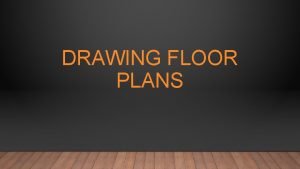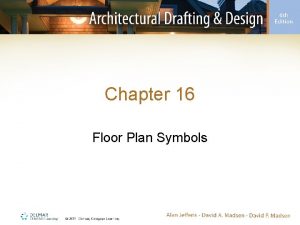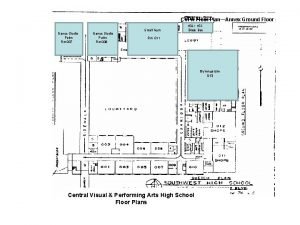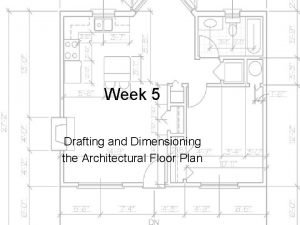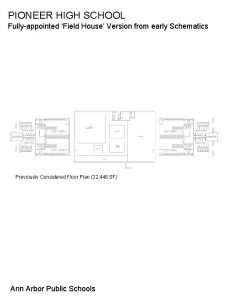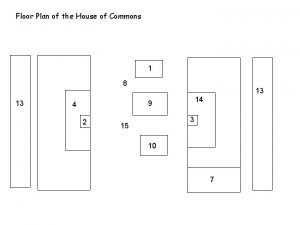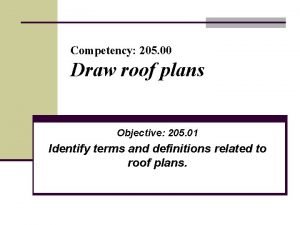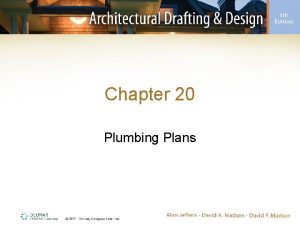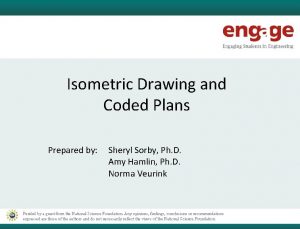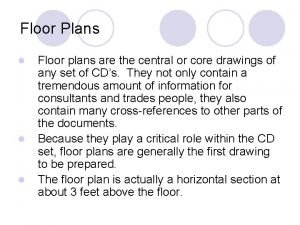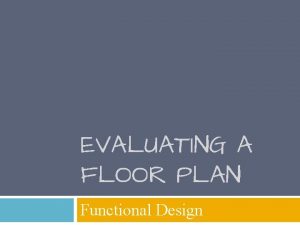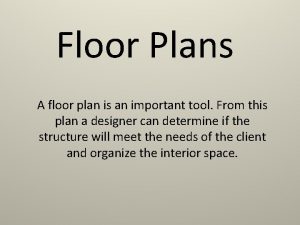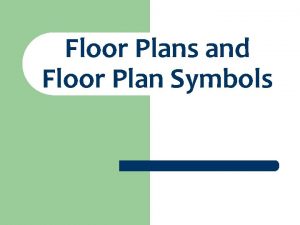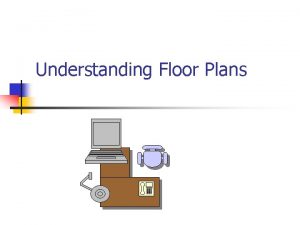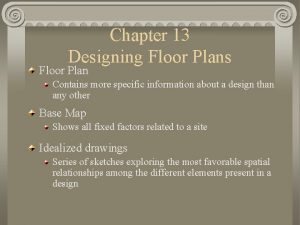DRAWING FLOOR PLANS THE FLOOR PLAN The purpose













- Slides: 13

DRAWING FLOOR PLANS

THE FLOOR PLAN • The purpose of the floor plan is to show precise locations and dimensions of walls windows, doors, appliances, fixtures, cabinets and other fixed features. • Usually started first and may be finished last • All other drawings refer to or project from the floor plan • Is a sectional drawing with the cutting plane at approximately 4’ above the floor.

DRAWING A FLOOR PLAN • Determine the scale that will allow you to fit the drawing onto the assigned sheet size. • ¼” = 1’-0” is most often used for residential floor plans • Scale varies with paper size, details, and scope of project.

PROCEDURE FOR DRAWING. • Using an appropriate scale, block in the overall size of the structure. • Allow space for adding dimensions and annotation. • Allow space for exterior features. • Layout exterior and interior walls. • Locate and draw/insert door and window symbols. • Layout and draw kitchen cabinets/fixtures and bathroom fixtures. • Add dimensions, annotation, and room names.

PROCEDURE FOR DRAWING (CONT. ) • Add miscellaneous symbols. • Locate and draw walks, patio, porch, and/or deck. • Add material symbols an annotation. • Draw/insert title block and indicate scale, date, drafter, revisions, etc. • Check throughout for drawing accuracy and content.

DIMENSIONING AND ANNOTATION 1. Exact methods vary with different designers. 2. All features must be located and sized completely and accurately 1. Builder becomes the designer if measurements are left off. 2. Errors are costly both in time and money.

DIMENSIONING AND ANNOTATION GENERAL PROCEDURES 1. dimension lines are generally unbroken with 1/8” tall numbers place above the line 2. dimension lines should be ¾” or more off of the object and at least ¼” apart. 3. Foot and inch marks are used with a dash between the food and inch numerals. 4. Measurements over 1’ are written in feet and inches, less than 1’ are expressed in inches only, if no inches are present, the foot must be followed by a zero inches ( ex. 5’-0”)

GENERAL PROCEDURES • Used the aligned system ( read from the bottom and right) • Dimension lines, extension lines, center lines, and leaders are thin. • Curved leaders are sometimes used to avoid confusion with straight lines of the building. • Avoid crowding dimensions.

PLACEMENT OF DIMENSIONS • Interior frame walls are dimensioned to either the side, center, or both sides of the stud. • Exterior frame walls are commonly dimensioned to the face of the stud or sheathing excluding the exterior finish. • Masonry structures are typically dimensioned to face of the masonry material for exterior and interior walls.

PLACEMENT OF DIMENSIONS • Masonry veneer walls are typically dimensioned to the outside of the stud or sheathing; an additional dimension is used to size the cavity and masonry material thickness. • Windows and doors are located by centerlines in frame and veneer construction, • Windows and doors are located by the edges of their openings in masonry walls.

MODULAR DIMENSIONS • Structures produced using modular components waste fewer materials and therefore cost less. • Typical modular considerations • Exterior walls should be modular lengths of 4’ or at least 2’ • Plan rooms with an eye on standard sizes; building materials are sold in increments of 2’ • Concrete blocks use an 8” module and brick works on a 4” module • Plan structure with material sizes in mind • Lumber lengths • Plywood/osb is 4’x 8’

DIMENSIONS AND ANNOTATION • Dimensions must be checked for accuracy • Total offset strings and compare to stated overall dimensions • Check stated dimensions against scaled distances.

ANNOTATION • Room names should be given with 3/16” lettering and centered as much as possible. • A label should identify all fixtures such as washer, dryer, dishwasher, sing, range, etc. using proportionately sized text. • Title and scale are placed near the bottom of each individual drawing and detail • Title block includes sheet number , name of drawing, scale, date, drafter, client and other important information. • Door and window sizes may be given on the floor plan or symbols may be applied for reference to a schedule. • Label unusual or special features.
 Purpose of floor plan
Purpose of floor plan Shop floor applications
Shop floor applications Mathematical literacy floor plans
Mathematical literacy floor plans Mathematical literacy grade 11 assignment 2 maps and plans
Mathematical literacy grade 11 assignment 2 maps and plans Kitchen floor plan symbols
Kitchen floor plan symbols Dance studio floor plans
Dance studio floor plans Thickness of wall in floor plan
Thickness of wall in floor plan High school field house floor plans
High school field house floor plans Plan of house of commons
Plan of house of commons Drawing roof plans
Drawing roof plans 20 20 plumbing
20 20 plumbing Isometric shapes
Isometric shapes Which process is this
Which process is this What is a sentence purpose
What is a sentence purpose
